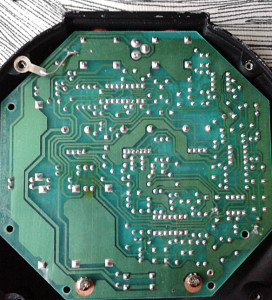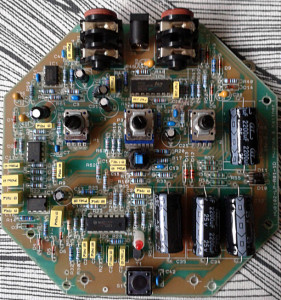What is it?
Hughes & Kettner Warp Factor from early 00’s.
The unit here has seen a lot of use before landing in to my collection. There are good reasons for pros and cons and both are weighting more than with usual pedals we see. Since the positive notions are all mostly on the sound, i think it’s best too look at everything else first. Opening the bottom plate shows a massively sized modern board with lots of joints.
Flipping the board over. Everything is board mounted and number of through hole components is high. Not a bad looking board design, but as i am a huge fan of symmetry, it doesn’t mean that much. Note the four 2200µF filtering capacitors. That’s what we’ll need when the design calls for 12V AC power supply. The supply is rectified to DC on board, which does explain a part of the board and enclosure size. The schematic can be found on the web (try freestompboxes.org), but since it isn’t behind simple image search, i’m not posting it for now.
Design is rather huge, and the power supply section spews out +15V and -15V, with reference voltages per each polarity. We could say the unit runs at 30V. So this time there is a fairly good reason for running the effect with 12V AC supply. Circuit design and supply together, however, make the pedal big. And to have a need for 12V AC supply may also be a hassle. But then again, the 30V swing offers headroom that we won’t reach with with 9V DC supply.
As for features, we have electronic bypass switching, level and gain controls, plus a deep tone control called warp. The sub switch boosts lows and low mids to a degree which is rather impressive.
Now, if the size was a bit smaller and this accepted more usual power supply…
How does it sound?
F*n awesome. From Marshall 2203 JCM800-styled massive rock overdrive/distortion to sheer metal madness, this unit sounds great on any volume level. From bedroom practice amp level to loud rehearsals and gigs. I’ve been a fool for many metal distortions before, but none of them has ever left a impact of this size. Usually the drive/gain setting for metal distortions works in maximum setting or in some cases at minimum as well. For this one, the control range is simply usable all the way of the sweep. Added low frequencies from the sub switch make Boss HM-2’s crushing lows feel like a mosquito passing by. While the usability may be limited, we still have a colorful range from rock overdrive to rock distortion to metal distortion to massive metal sounds. Very impressive pedal.




Hi there. I purchased one of these with a bad switch. How did you get the bottom plate off? I removed the knobs, unscrewed the 4 black screws on the bottom and removed the nuts from the switch and the jacks. It won’t budge. Any help would be wicked helpy. Thanks!!
Can’t remember. It’s been a while and the pedal is currently in one the boxes i have for storage…
+m
Thanks for the write up. This is excellent information. After trying every possible distortion pedal this was the one that sounded the best to me, beating out the RAT, OCD and the EVH 5150 pedal.
I bought this pedal about two years ago for $100 as new old stock on Reverb. Who’d have thought that a “Nu-Metal” marketed distortion pedal would sound so awesome and give such a great tone through my H&K Tubemeister 18 Head and TM112 cabinet. It sounds nothing like Alien Ant Farm or Papa Roach lmao.
I had the same issue with the switch being sticky and unreliable. I had planned on fixing it but couldn’t get the back off. Then I kind of forget about it after putting it back in the box. Having recently moved I decided to pull it out again to attempt a repair and now it’s completely dead.
I’m planning on taking it to an electronics repair place near me to see about getting it fixed and the switch swapped out for something a bit heartier. I know this is many years old at this point but I’ll update you on how to get thye back off once I get it back and speak to the repair tech.
– Douglas
How do you get bottom plate off.
Hi
Can anybody tell me what are the the zener diode used in D13 & D12?
Mine got fried due to over power.
TIA